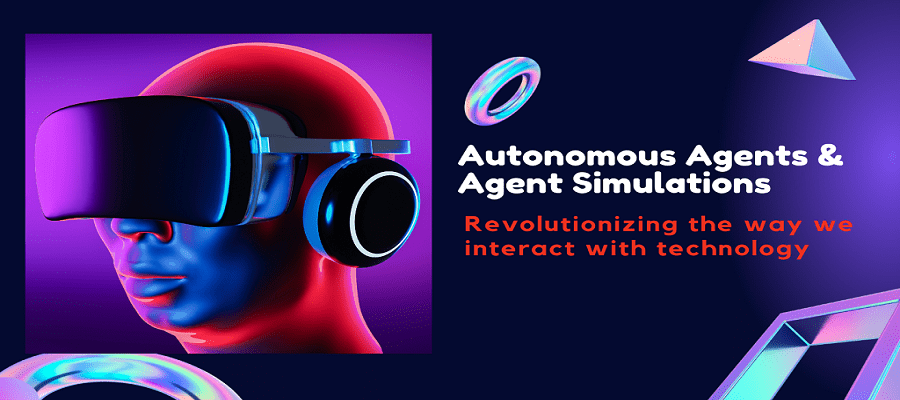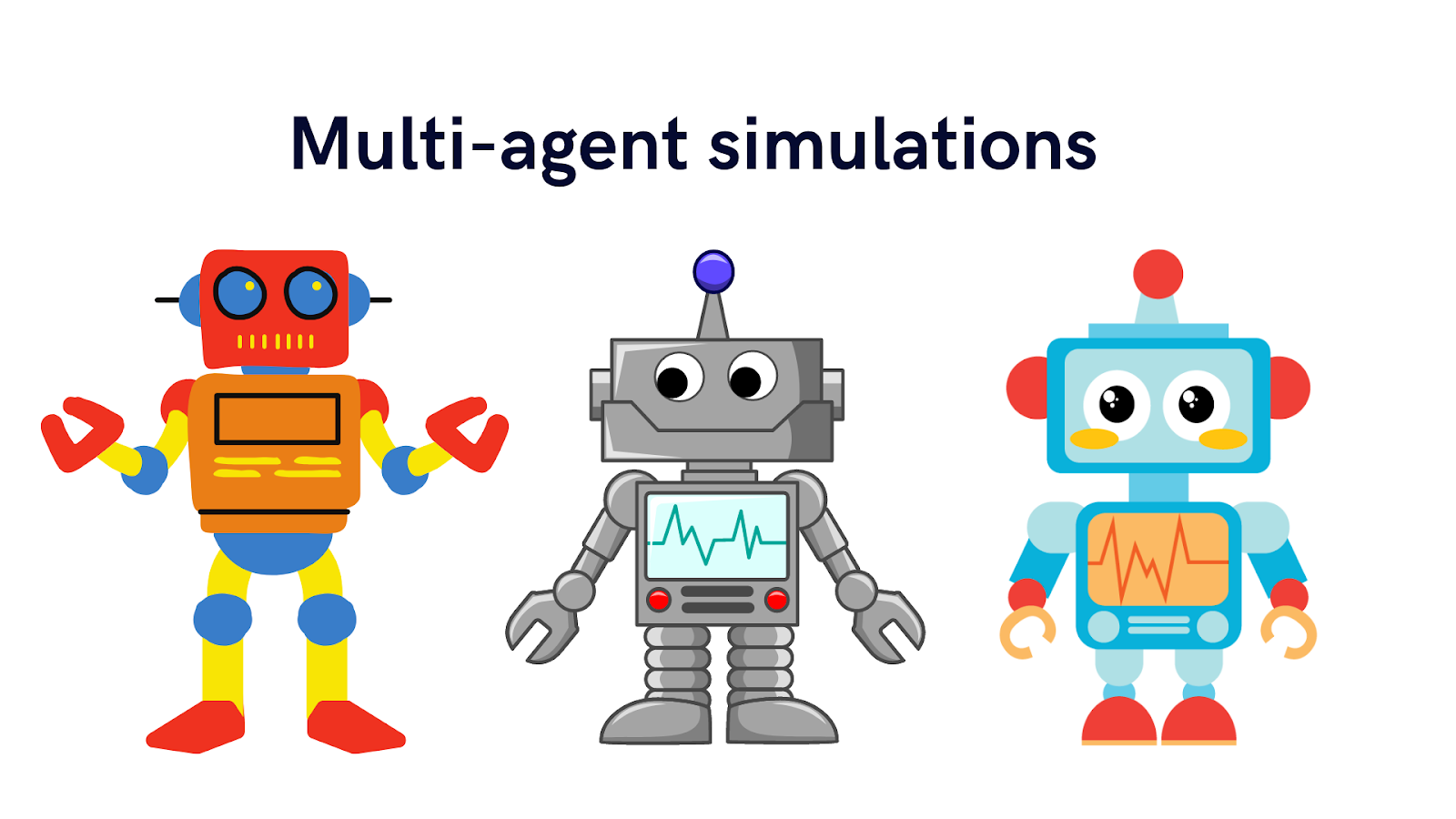
Artificial Intelligence (AI) has become one of the most significant technological advancements of our time. AI is changing the way we live, work, and interact with the world around us. From virtual assistants like Siri and Alexa to self-driving cars and personalized recommendations on social media and every small thing we do on our laptops and mobiles are all AI, it is revolutionizing the way we interact with technology. In this blog, we learn what is autonomous agents and agent simulations. Let's dive in!
Have you noticed how much more we're interacting with AI these days? From chatbots to personalized ads, AI seems to be everywhere we look. In recent years, there has been a massive increase in the use of AI across various industries. This is because AI has proven to be an incredibly effective tool for processing and analyzing large amounts of data, providing valuable insights and improving efficiency. AI is being used in healthcare, finance, transportation, retail, and even agriculture. With AI becoming more accessible and user-friendly, we can expect to see even more growth in its use in the years to come. The possibilities are endless!
Artificial intelligence uses Logic Learning Machine (LLM) to learn from data logically. Because it can handle both organized and unstructured data, as well as learn from incomplete or noisy data, it differs from conventional machine learning algorithms. LLM has the benefit of producing models that are explicable, which means that the justification for its judgments can be linked back to logical principles that it has learned.

Autonomous agents are computer programs that can perform tasks and make decisions on their own without human intervention. These agents are designed to act independently, and they use algorithms and decision-making models to carry out their tasks. Algorithms are sets of rules or procedures that are used to solve problems or perform specific tasks. In AI, algorithms are used to analyze data, identify patterns, and make predictions. Machine learning algorithms, for example, can learn from data and improve their performance over time. Decision-making models are used in AI to help machines make choices and take action. These models typically involve a set of rules or logic that dictate how the machine should behave based on certain inputs or conditions.
Autonomous agents are commonly used in applications such as robotics, self-driving cars, and chatbots. These agents can perceive their environment, make decisions based on that perception, and take action accordingly. They can also learn and adapt over time, improving their performance as they gather more data and experience. The goal of autonomous agents is to make our lives easier and more efficient by taking on tasks that would otherwise require human intervention.
Autonomous agents possess several key characteristics that enable them to function independently. Below are a few characteristics
Autonomous agents have a wide range of applications across various fields. Here are a few examples:
Autonomous agents are powerful computer programs that can operate independently, perceive their environment, reason, make decisions, and achieve specific goals. Their applications span across various domains, from robotics and virtual assistants to autonomous vehicles and financial trading. As technology continues to advance, the capabilities of autonomous agents are expected to grow, leading to more sophisticated and intelligent systems.
There are different types of autonomous agents, each with its own capabilities and characteristics. Here are some prominent types.

Agent simulations are a powerful tool that allows researchers to test different scenarios and see how they impact the system as a whole. they are computer-based models used to simulate the behavior and interactions of autonomous agents in a virtual environment. These simulations are used in a variety of fields, including economics, biology, etc.
In agent simulations, each agent is programmed to follow a set of rules and behavior patterns, and they interact with other agents in the environment. The interactions can be based on a variety of factors, such as social networks, economic incentives, or biological characteristics. By modeling these interactions, researchers can gain insights into how these systems work and how they might behave in the real world.
Examples of agent simulations include simulations of traffic flow, economic markets, and disease outbreaks. By modeling the behavior of agents in these scenarios, researchers can gain insights into how these systems work and develop strategies for improving their performance or minimizing their negative impacts.
Agent simulations play a significant role in the field of artificial intelligence (AI). They are used to model and simulate complex systems, including societies, traffic, and human behavior. Agent-based simulations involve creating individual agents that interact with each other and their environment based on predefined rules or behaviors. These simulations can provide valuable insights into the collective behavior of agents and help in understanding and predicting real-world phenomena.
Agent-based simulations have been applied in various domains, including climate, energy, epidemiology, conflict management, and child abuse. They have also been used in the development and validation of automated driving systems, such as Waymo's multi-agent simulation environment Carcraft. Additionally, agent-based simulations are used for training environments in multi-agent reinforcement learning schemes.
The combination of agent-based simulation with reinforcement learning is considered a promising approach in AI. It allows for the development of continuously learning agents that can adapt and improve their behavior over time. This combination has the potential to go beyond traditional deep learning methods and enable more sophisticated AI systems.
Overall, agent simulations in AI offer a powerful tool for modeling and understanding complex systems, training AI agents, and predicting real-world behavior.
In the field of economics, agent simulations have revolutionized the study of market behavior. By simulating the actions of individual buyers and sellers, researchers can gain insights into market trends, the impact of different pricing strategies, and the emergence of market inefficiencies. These simulations allow economists to test hypotheses and theories in a controlled environment, providing a deeper understanding of economic phenomena.
Agent simulations also play a crucial role in the field of transportation planning. By modeling the behavior of individual drivers, traffic flow, and road infrastructure, researchers can optimize traffic management strategies and predict the impact of new road constructions. These simulations help planners identify congestion hotspots, improve road safety, and design efficient transportation systems.

Multiple autonomous agents communicate with one another in a virtual world during a multi-agent simulation. Each agent can interact and work together with other agents to accomplish their objectives. Each agent has its own set of rules and decision-making procedures. A powerful tool for studying a variety of systems, including social networks, economics, ecological systems, and transportation networks, is multi-agent simulation.
The ability to model complex systems and examine emergent behaviors that result from the interactions of several agents is one of the advantages of multi-agent simulation. Multi-agent simulation can be used by researchers to examine the behavior of city traffic flow or the transmission of a disease among a population, for instance. Researchers can get insights into how these systems function and how they might be improved by modeling the behavior of individual actors.
In multi-agent simulations, each agent is an autonomous entity that follows a set of rules or behaviors. The agents interact with each other and their environment, and their collective behavior emerges from these interactions. The goal of multi-agent simulations is to gain insight into the collective behavior of agents and understand how simple rules or behaviors at the individual level can lead to complex system-level outcomes.
Multi-agent simulations have been used in various scientific domains, including biology, ecology, social science, climate modeling, energy, epidemiology, conflict management, and more. They are also used in fields like transportation, where vehicular traffic with controlled autonomous vehicles can be modeled as a multi-agent system involving crowd dynamics.
One advantage of multi-agent simulations is the ability to model interactions between different agents, allowing for the study of complex systems with diverse entities.
These simulations can help researchers and decision-makers gain insights into the behavior of systems, make strategic and tactical decisions, and test coordination mechanisms.
It's important to note that multi-agent simulations can be complex and computationally demanding, as they require defining interactions between agents and between agents and the environment. However, they provide a valuable tool for studying and understanding the behavior of complex systems.
Overall, multi-agent simulations are a powerful tool for studying the behavior of autonomous agents and their interactions in various domains, providing insights into the dynamics and emergent properties of complex systems.
The applications of multi-agent simulations are vast and diverse. Let's explore some of the areas where these simulations have found their significance;
Multi-agent simulations have emerged as a powerful tool in various fields, ranging from social sciences to computer science and beyond. By simulating the behavior and interactions of multiple agents within a given environment, these simulations offer a unique perspective into complex systems. In this article, we will explore the benefits of multi-agent simulations and their applications in different domains.
One of the key benefits of multi-agent simulations is their ability to model and understand complex systems. By simulating the interactions between multiple autonomous agents, researchers can gain insights into emergent behavior, self-organization, and the overall dynamics of the system. This understanding is crucial in fields such as economics, ecology, transportation, and social sciences.
Multi-agent simulations provide a platform for testing and refining decision-making processes. By simulating various scenarios and allowing agents to interact and adapt, researchers can analyze the impact of different strategies and policies. This helps in optimizing resource allocation, streamlining processes, and improving overall efficiency in areas such as logistics, supply chain management, and urban planning.
With the ability to model complex systems, multi-agent simulations also lend themselves to prediction and forecasting. By incorporating historical data and simulating future scenarios, researchers can make informed predictions about the behavior and outcomes of the system. This is particularly valuable in areas such as climate modeling, epidemiology, and financial markets, where accurate predictions can have significant implications.
Multi-agent simulations offer a controlled environment for testing and validating theories and hypotheses. Researchers can create virtual experiments to study the impact of different variables and parameters on the system. This not only helps in understanding the underlying mechanisms but also reduces the need for costly and time-consuming real-world experiments.
Multi-agent simulations have found applications in training and education. By creating simulated environments that mimic real-world scenarios, individuals can gain practical experience and develop problem-solving skills. This is particularly useful in fields such as military training, disaster management, and healthcare, where real-world training may be limited or expensive.
Multi-agent simulations provide a powerful tool for policy design and analysis. By simulating the behavior of multiple agents, policymakers can evaluate the potential impact of different policies on the system. This helps in making informed decisions and developing effective strategies to address complex societal challenges.
autonomous agents are a fascinating area of research that has the potential to revolutionize many different fields. By modeling the behavior of agents in a virtual environment, researchers can gain insights into how complex systems work and develop innovative solutions to world problems.
As our understanding of AI and machine learning continues to evolve, we can expect to see more and more autonomous agents being developed and deployed in the real world.